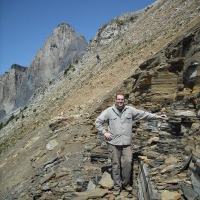
John Paterson
John completed his Bachelor of Science majoring in geology and palaeontology at Macquarie University (Sydney) in 2000, and was awarded First Class Honours in 2001 for his research on Ordovician (470 million-year-old) fossils from western New South Wales. His PhD studies at Macquarie University (2002-2005) were centered on Cambrian to Ordovician (520 to 470 million-year-old) trilobites – an extinct group of marine arthropods that are distantly related to crustaceans and insects – from around Australia, including New South Wales, South Australia, Queensland and Victoria.
John’s research contributions have primarily focused on documenting the palaeo-biodiversity of Australian Cambrian and Ordovician biotas (ca. 444 to 541 million years ago) and using these key fossils to answer major questions relating to evolution, biogeography and palaeoecology during this critical time interval. He has also used these fossils in the relative dating and correlation of strata around the globe in order to refine the geologic timescale. The multidisciplinary nature of his work includes numerous publications on taxonomy, phylogeny, biostratigraphy, biogeography, taphonomy and palaeoecology.
John’s current research focuses on Cambrian (540-510 million-year-old) fossils, especially from the Flinders Ranges and the globally significant Emu Bay Shale Konservat-Lagerstätte on Kangaroo Island in South Australia. His main area of expertise lies in arthropods, although he also studies molluscs, brachiopods, “worms” and other enigmatic organisms. John is very active in the Australian and international palaeontological communities. He was the Secretary of the Association of Australasian Palaeontologists from 2006 to 2010, and is currently a Voting Member of the International Subcommission on Cambrian Stratigraphy.
Google Scholar profile: http://scholar.google.com.au/citations?user=aYcIfKwAAAAJ&hl=en
Address: Earth Sciences
University of New England
Armidale NSW 2351
Australia
John’s research contributions have primarily focused on documenting the palaeo-biodiversity of Australian Cambrian and Ordovician biotas (ca. 444 to 541 million years ago) and using these key fossils to answer major questions relating to evolution, biogeography and palaeoecology during this critical time interval. He has also used these fossils in the relative dating and correlation of strata around the globe in order to refine the geologic timescale. The multidisciplinary nature of his work includes numerous publications on taxonomy, phylogeny, biostratigraphy, biogeography, taphonomy and palaeoecology.
John’s current research focuses on Cambrian (540-510 million-year-old) fossils, especially from the Flinders Ranges and the globally significant Emu Bay Shale Konservat-Lagerstätte on Kangaroo Island in South Australia. His main area of expertise lies in arthropods, although he also studies molluscs, brachiopods, “worms” and other enigmatic organisms. John is very active in the Australian and international palaeontological communities. He was the Secretary of the Association of Australasian Palaeontologists from 2006 to 2010, and is currently a Voting Member of the International Subcommission on Cambrian Stratigraphy.
Google Scholar profile: http://scholar.google.com.au/citations?user=aYcIfKwAAAAJ&hl=en
Address: Earth Sciences
University of New England
Armidale NSW 2351
Australia
less
Uploads
Papers by John Paterson